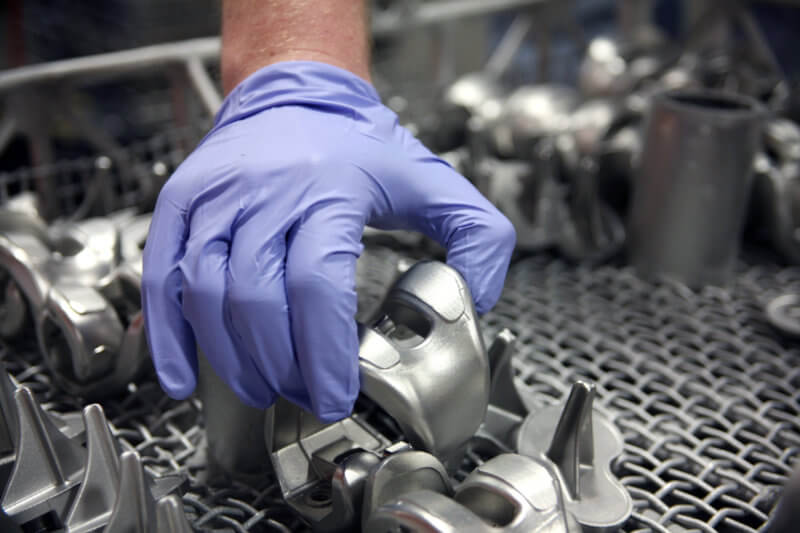Ask the Expert: Solar Atmospheres of Western PA’s Sales Director Outlines Part and Furnace Preparation Prior to Vacuum Heat Treatment

1. What are some of the first steps I should take before sending parts out for vacuum heat treating?
Before vacuum thermal processing, ensuring the parts are free of foreign object debris (FOD) is essential. This includes removing contaminants like manufacturing oils, coolants, and machining residue. It’s also important to communicate whether the coolant used was water-based or oil-based—this helps your heat treater select the most effective cleaning method.
Many vacuum heat treaters use solvent degreasers for oil-based coolants and hot water/soap-based rinses for water-based coolants. Providing this information up front helps determine how to best prepare your parts for heat treatment.
Bottom line: Failing to address FOD can result in spotting, discoloration, or worse—surface contamination.
2. You made sure the parts are clean; now, how about the vacuum furnace?
Much like a home oven, vacuum furnaces require periodic cleaning—referred to in our world as a “bake-out.” This process removes residual FOD or contaminants left from previous runs.
Typical bake-out temperatures:
- Austenitic (300-series) steel grids, fixtures, and baskets: ~2150°F
- Furnace-only bake-out: ~2300–2400°F
Reaching these temperatures ensures even entrapped moisture in graphite components is eliminated—crucial for maintaining a clean process environment.
3. Okay, so the parts are clean and the furnace is clean. Are we ready to run?
Almost! One final but critical step: check the furnace leak rate.
- For most steels, aim for 20 microns/hour or less
- For reactive metals (like titanium), 5 microns/hour or less is ideal
Remember, all vacuum furnaces leak to some degree—perfection doesn’t exist in commercial heat treating. But keeping leak rates low is key to producing bright, shiny, contamination-free parts.
4. Now for the easy part: the thermal cycle. Right?
Well… not quite!
If you’re using partial pressure gas or backfill gas (nitrogen, argon or helium), you must also monitor the dew point and oxygen content of the process gas. When treating alloys that oxidize easily—even small traces of water vapor or oxygen can cause surface issues.
While dew point measures moisture, it does not measure oxygen. Using oxygen sensors alongside dew point monitoring provides a more complete picture of gas purity, ensuring optimal conditions for clean, bright results.
Also, consider the vacuum level:
- For 300/400 series stainless steels or PH alloys, a vacuum in the 10⁻⁴ Torr range (graphite hot zone) is typically sufficient.
- For titanium or reactive alloys, you’ll need a 10⁻⁶ Torr vacuum, which usually requires an all-metal (molybdenum) hot zone.
While graphite furnaces are capable, all-molybdenum systems offer superior part cleanliness for highly reactive materials.
Lastly, ensure proper thermocoupling of the load. Use contact thermocouples directly in a part or in a heat sink that represents the maximum cross-section. Poor thermocoupling can lead to a false sense of temperature stability—you may think the load is cool, but when the door opens, parts could still be hot enough to oxidize instantly (turning blue).
 5. I followed all your recommendations, and the parts are still discolored! Why?
5. I followed all your recommendations, and the parts are still discolored! Why?
Even with every precaution, discoloration can still occur—and it’s understandably frustrating. But it’s important to distinguish between:
- Discoloration, which is superficial and doesn’t impact performance
- Surface contamination, which is detrimental, as it alters the surface microstructure
To confirm the difference, consider sending a representative part to a metallography lab. These labs can characterize the near-surface condition, helping you determine next steps—ranging from simple Scotch-Brite cleaning, to a chemical or mechanical etch that removes a few thousandths of material.
And featured in Today’s Medical Developments Magazine: https://www.todaysmedicaldevelopments.com/article/solar-atmospheres-sales-director-outlines-part-furnace-preparation-prior-vacuum-heat-treatment/

 5. I followed all your recommendations, and the parts are still discolored! Why?
5. I followed all your recommendations, and the parts are still discolored! Why?